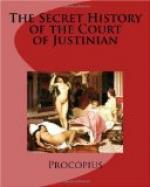As for the private fortunes of individual Romans, he confiscated them for his own use in all parts of the empire, either by accusing their possessors of some crime of which they were innocent, or by distorting their words into a free gift of their property to him. Many were convicted on these charges of murder and other crimes, and in order to escape paying the penalty for them, gave him all that they had. Some who were engaged in making frivolous claims to land belonging to their neighbours, when they found that they had no chance of winning their cause, as the law was against them, would make him a present of the land in dispute, and so get out of the difficulty. Thus they gained his favour by a gift that cost them nothing, and got the better of their adversaries by the most illegal means.
It will not be out of place, I think, to describe his personal appearance. He was neither tall nor too short, but of a medium height, not thin, but inclined to be fat. His face was round and not ill-favoured, and showed colour, even after a two days’ fast. In a word, he greatly resembled Domitian, Vespasian’s son, more than anybody else. This was the Emperor whom the Romans detested so much that they could not slake their hatred for him, even when they had torn him to pieces, but a decree of the Senate was passed to remove his name from all documents, and that all statues of him should be destroyed; wherefore his name has been erased from every inscription at Rome and everywhere else, except where it occurs in a list together with other emperors, and no statue of him is to be found in the Roman Empire, save one only, the history of which is as follows: Domitian had married a lady of noble birth and admirable conduct, who never harmed anyone, and always disapproved of her husband’s evil deeds. As she was so much beloved, the Senate sent for her, after the death of Domitian, and bade her ask whatever favour she pleased. All that she asked was to receive Domitian’s body for burial, and permission to erect a bronze statue to him in whatever place she might choose. The Senate consented, and Domitian’s wife, not wishing to leave to posterity a memorial of the brutality of those who had butchered her husband, adopted the following plan. She collected the pieces of his body, pieced them accurately together, joined them properly, and sewed the body together again. She then sent for the statuaries, and bade them reproduce this pitiable object in a brazen statue. The workmen straightway made the statue, and his wife, having received it from them, set it up in the street which leads up to the Capitol from the Forum, on the right hand side, where to this day one may see Domitian’s statue, showing the marks of his tragic end. One may say that the whole of Justinian’s person, his expression, and all his features can be traced in this statue.




